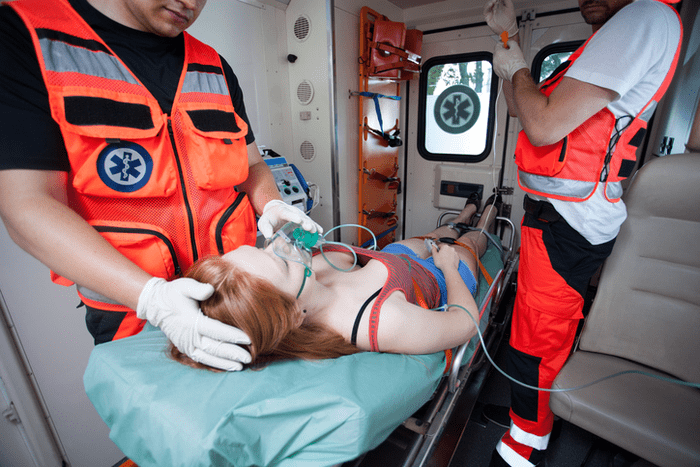
Anyone working in patient care knows how important oropharyngeal suctioning is to maintaining airway patency. Not only does it remove bodily fluids (blood, mucus, saliva, and vomit) from the airway, but it also allows visualization of the vocal cords during intubation—a crucial step in establishing an advanced airway.
Like any treatment you render, whether in the prehospital or hospital setting, there are dangers inherent to oropharyngeal suctioning. Fortunately, with pre-planning and a cautious approach, these dangers can be minimized and even eliminated. Let’s explore several of the dangers of oropharyngeal suctioning, and how you can avoid these pitfalls.
Does the Patient Need Suction?
Before suctioning your patient, you must first determine the need. A cursory glance at your patient can sometimes indicate the need for suction, but you may need to assess to be sure. Here are some signs that your patient may need suctioning:
- Increased difficulty breathing
- Nasal flaring
- Use of accessory muscles
- Abnormal positioning, like tripod or the inability to lay flat
- Abnormal respiratory patterns
- Evidence of a partial or complete obstruction
- Excessive secretions
Any of the above could indicate that your patient requires oropharyngeal suctioning, so be sure to include portable suction in your normal ALS equipment lineup.
Tips for Suctioning
If you've determined your patient needs suctioning, here are a few tips to remember:
- Place the patient in a position of comfort, when possible. In cases of suspected spinal trauma, elevate the head of the backboard (if not contraindicated) to assist in fluid removal.
- Preoxygenate the patient. The greatest danger of prolonged suctioning is hypoxemia. To avoid this, preoxygenate your patient with 100% oxygen and limit suction time to under ten seconds. Your goal is to maintain a SpO2 at or above 95 percent.
- Technique is key. Use care when guiding the suction catheter to avoid traumatizing oral tissues. This is especially important in trauma, where the patient may have loose teeth that can become obstructions. Remember that tracheal irritation can lead to vagal stimulation, which can result in bradycardia and hypotension. Use the appropriate size catheter for maximum efficiency.
- Take extra care with unconscious patients. Open the airway using the appropriate method (jaw thrust in suspected trauma) and pre-oxygenate it by bagging for one-to-two minutes using 100% oxygen.
Suctioning the Tube
Having an endotracheal tube in place does not necessarily preclude the need for suction. When your patient's condition calls for suctioning the endotracheal tube, be sure to:
- Use a small, flexible French catheter.
- Prepare and assemble your equipment.
- Maintain universal precautions and use a sterile technique.
- Lubricate the suction catheter.
- Preoxygenate the patient.
- Measure the suction catheter tip from the corner of the mouth to the angle of the jaw, or insert into the endotracheal tube until the patient coughs.
- Using a twisting motion, apply suction as you remove the suction catheter.
- Suction for no longer than 10 seconds.
- Monitor the patient via pulse oximetry, capnography, and vital signs.
- Continually reassess the airway, endotracheal tube, and lung sounds.
- Pre-oxygenate your patient in between each suction procedure.
Special Populations
Some patients require additional caution during oropharyngeal suctioning. Here are some important tips to keep in mind.
Geriatric Patients
One group that may require special considerations when suctioning is geriatric patients. To avoid complications:
- Be alert for dentures or other dental devices when managing the airway.
- Removing dentures may make intubation easier, but may complicate the mask seal.
- Broken teeth are likely to become obstructions.
- Aspiration is always a danger if your patient has a reduced cough reflex.
- Chest wall stiffness may lead to reduced tidal volume.
- Kyphosis may complicate patient positioning; use extra padding when needed.
- Nasal tissues are more fragile, especially for patients on anticoagulants.
- Hypoxia can progress, even in minor chest injuries, so continually reassess.
- Older patients may rely more on a diaphragmatic excursion, so do not impede the abdomen when securing your patient on a backboard.
Pediatric Patients
Pediatric patients may also face specific dangers during oropharyngeal suctioning. Since children are unable to communicate their conditions as effectively as adults, be alert for signs of respiratory distress, such as:
- Rapid or labored breathing
- Nasal flaring
- Use of accessory muscles
- Grunting
- Wheezing
- Abnormal breath sounds
- Retractions
- Positioning (tripod)
- Irritability
- Lethargy
- Exhaustion
Suctioning newborns and infants requires an especially delicate touch. They are typically obligate nose breathers, so don’t forget to suction the nasal passageways when treating the very young. Below are some other best practices:
- Suction small children or infants using a flexible catheter.
- Suction the mouth first, then the nose.
- Advance the catheter until the tip contacts secretions.
- Block the side port with your thumb and use a twisting motion as you withdraw the catheter.
- Do not suction beyond your direct vision to avoid gagging, vomiting, or aspiration.
- Insert the catheter into the nose and follow the same technique by applying suction and removing it with a twisting motion.
Watch for Danger Signs
As you assess and reassess your patient during and between suctioning, stay alert for signs of trouble, which may include:
- Hypoxemia
- Cardiac arrhythmias
- Airway trauma with associated bleeding
- Increased intracranial pressure
- Buildup of mucus plugs
Although there are dangers to oropharyngeal suctioning, the benefits far outweigh the risks. You can minimize or eliminate the dangers by utilizing a thoughtful, cautious approach.
Editor's Note: This blog was originally published in May of 2022. It has been re-published with additional up to date content.















